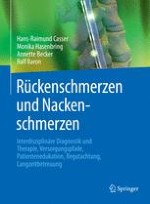Zusammenfassung
Als »multimodale Schmerztherapie« wird eine inhaltlich eng abgestimmte multidisziplinäre und integrative Behandlung in Kleingruppen bezeichnet. Eingebunden sind somatische, körperlich und psychologisch übende sowie psychotherapeutische Verfahren. Bei chronischen Schmerzsyndromen mit komplexen körperlichen, seelischen und sozialen Folgen ist eine Therapieintensität von mindestens 100 h notwendig. Unter diesen Voraussetzungen ist das Verfahren anderen Therapiearten nachweislich überlegen, und im Falle eines Versagens monodisziplinärer und/oder ambulanter Maßnahmen haben gesetzlich Versicherte einen rechtlichen Anspruch darauf. Eine medizinische Indikation besteht bei Patienten mit bereits chronifizierten Schmerzsyndromen, aber auch bei erhöhtem Chronifizierungsrisiko mit dem Ziel, den Chronifizierungsprozess aufzuhalten. Relative Kontraindikationen sind fehlende Veränderungsmotivation, ausgeprägte psychische Störungen, schwerere Psychopathologien und Suchtproblematik. Die Versorgungslage ist in der BRD derzeit ungenügend.











